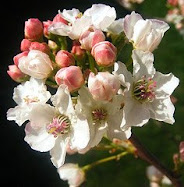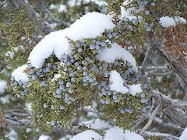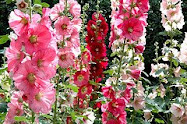 “The misunderstanding I have with Nature over my perennial border,” writes gardener Sara Stein, “I think it is a flower garden. She thinks it is a meadow lacking grass, and tries to correct the error.” A similar misunderstanding and attempted “correction” plays out in my garden every year. Since the garden is meant to cover the whole of the lot, however, the annual war of the grass weeds is fought across the entire yard, not just in borders.
“The misunderstanding I have with Nature over my perennial border,” writes gardener Sara Stein, “I think it is a flower garden. She thinks it is a meadow lacking grass, and tries to correct the error.” A similar misunderstanding and attempted “correction” plays out in my garden every year. Since the garden is meant to cover the whole of the lot, however, the annual war of the grass weeds is fought across the entire yard, not just in borders.The primary foe in the ongoing skirmishes is a wild prairie grass, called little bluestem or wiregrass (pictured here), seconded in the field of contention by common lawn grass. The surface of the lot is covered in cypress wood chips, and at this writing, about one-third of the lot also hosts garden shrubs, trees and plants. The wood-chip covered areas do not have garden plantings because time and money did not allow the whole lot to be landscaped at one fell swoop. While the gardened areas are added to and expanded each year, the wild grasses have been able to establish in swathes along the sides, front and back perimeters of the lot. Every fall, opportunistic tumbleweeds of grass seed blow into the yard from neighboring yards and meadows, and every spring the patches of prairie and lawn grasses merrily resprout in unsightly, random clumps and ragtag bands.
The grasses are incredibly resilient and disgustingly healthy. The gardener tromps around on them in all seasons, digs them out, never waters them, and regularly directs curses and spells towards them, all to no avail. They grow, as grasses are wont to do, like the dickens, and every summer must be mowed down every three weeks or so. Since mowing a lawn was never part of the garden plan, the gardener must needs borrow a lawnmower for this obnoxious task from a neighbor, then has to inflict a couple hours' worth of extremely unpleasant and harmful lawnmower gasoline engine fumes on the environs, and finally has to re-mulch all the mowed areas with new cypress chips, since the lawnmower chops and blows the ground cover to smithereens, leaving behind sad, bare stretches of earth.
Last year, the gardener attempted a more resounding assault upon the invaders. Using the weed-killer Round-Up, the blades of the grasses were sprayed as they emerged, primarily in the places where they were extending their reach toward the flower beds, and on the random scatterings of outcroppings in new, previously uncolonized locations. If the spraying occurred on a sunny day that was followed by at least a week or two of more sunny days and no rainfall (chance would be a fine thing!), most (not all) the sprayed grasses would, in fact, turn yellow, then brown, and die. The roots, apparently, seldom if ever met a like fate, as within another couple weeks, new grass infants would be born in adjacent locations.
The herbicide spraying tactic will not be employed this year. Not because in the big picture it didn't really work, not because Round-Up is very expensive, relative to the garden budget, and the profits go to Monsanto, a multi-national chemical company that has been manufacturing horticultural, agricultural and military poisons for decades. The spraying won't be repeated because the gardener does not want to commit murder, not even a little bit of murder of the earth, and that is precisely what synthetic chemical herbicides, insecticides and fertilizers do. The war of the weeds got the better of the gardener's knowledge, common sense and principles last year. I lost my patience (and a little of my mind) in the heat of battle, and employed a strategy I abhor. Never again.
The death of the particular sprayed grasses is not the issue. Common lawn grass and little bluestem flourish ubiquitously throughout the Great Lakes and Midwest regions, and across prairies and yards on the whole North American continent. They are invasive, not by any stretch of the imagination endangered. But spray-bombing a single species of plant or insect is not a finite act. Toxic chemicals do not simply kill the species upon which they are applied. They debilitate everything they come into contact with, and once a poison chemical enters the ecosystem, it cannot be confined nor contained. An ecosystem is a contiguous whole, its parts cannot be isolated one from the others, and what befalls any of its individual parts will migrate, stealthy, silent and deadly, to all.
Chemicals sprayed on plants or insects enter and lodge in the seeds, pollen, eggs, roots, underwater streams, wells and water tables, dew and rainfall. Animals that feed on the plants or insects ingest the poison, and in turn also become poisoned and poisonous. Toxic substances thus spread from the single plant or insect to the soil, earthworms, creeks, rivers, lakes and oceans, fish and birds, wild and domestic animals, and human consumers of the plants and animals. Poisonous chemicals from herbicides and insecticides have been found in the seeds and subsequent generations of plants of sprayed species, they have been found in the honey produced by bees from the nectar of sprayed plants, and in the eggs and fledglings of birds that feed on poisoned insects. What's more, chemically poisoned plants and insects can develop a survival resistance to their assailants and undergo a flareback phenomenon wherein they resurge in greater, stronger numbers. To unleash a fusillade of poisons on any segment of the earth's ecosystem can render it unfit for all life forms, contaminating the entire environment.
So, the gardener made an egregious mistake last year, but has mended her errant ways, and approaches the garden and contemplates the flings of swaggering new grass sprouts with a revised, chastened attitude. Bands of rangy grasses here and there throughout the garden will be accepted as flagbearers of Nature's exuberance, will to live, and vibrant health on this little plot of land. A benign trowel or spade will root out any brigades of grasses that forge into no-go areas of flower beds. A non-polluting, manually operated rotary lawnmower will be acquired to keep the larger stretches of grass in trim. The gardener will henceforth bear in mind that the goal here is to make this village lot a better, more fecund and robust corner of the earth, rife with life and propitious to all comers. Pinching fingers or hungry praying mantis are still the best deterrent for tentworm caterpillars, after all, and ladybugs like no dinner menu better than aphids off the rosebush.









No comments:
Post a Comment